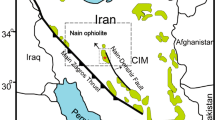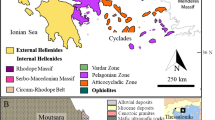Summary
Podiform chromitite bodies occur in serpentinites at Tehuitzingo (Acatlán complex, southern Mexico). Serpentinite and chromitite are believed to represent a fragment of Paleozoic ophiolitic mantle formed in a supra-subduction zone setting. The ophiolitic mantle sequence is associated with eclogitic rocks, enclosed in a metasedimentary sequence. This association suggests that serpentinites, chromitites and eclogitic rocks underwent a common metamorphic evolution, starting from high pressure (eclogite facies) followed by retrogression (epidote-amphibolite and greenschist facies).
The chromitites are strongly altered so that chromite grains are transformed to ferrian chromite; no primary silicates (i.e. of magmatic origin) have been preserved. The chromitites are Al-rich, and contain up to 303 ppb platinum group elements (PGE), with a marked predominance of Os + Ir + Ru over Rh + Pd + Pt, resulting in a characteristic negative-slope of the chondrite-normalized PGE pattern.
Consistent with the geochemical data the platinum group minerals (PGM) assemblage is dominated by Ru–Os–Ir minerals, occurring both as single-phase or as composite grains generally less than 10 µm in size. The PGM mineralogy includes laurite, osmium, irarsite and Ru–Fe oxide or hydroxide. Based on textural relations, paragenesis and composition, it was possible to establish that Os-rich laurite and irarsite were early liquidus phases, which now occur as inclusions in unaltered chromite. However, most of the PGM are found in the alteration assemblages of the chromitites in close association with ferrian chromite, chlorite, and heazlewoodite. Laurite from the secondary assemblage is Os-poor and commonly shows overgrowths of Os–Ir alloys. Internal zoning of some laurite grains indicates that Os-poor laurite formed from a Os-rich laurite by release of Os and some Ir, that are readily incorporated in the Os–Ir alloys. Such process requires a decrease of sulfur fugacity with decreasing temperature; this is not consistent with the fS2-T trend in magmatic systems. It is proposed, therefore, that the magmatic PGM assemblage underwent mineralogical reworking starting from relatively high temperature during metamorphism. Temperatures, estimated from chlorite geothermometry (399–210 °C), possibly reflect effects of low-grade metamorphism. After that the PGM and the associated sulfides started to be oxidized.
Although it is difficult to determine the extent of PGE mobilization on the basis of mineralogical observations, our data suggest that the metamorphism affecting the Tehuitzingo chromitites caused only re-distribution of PGE on a small scale. Thus, we conclude that metamorphism modified the primary PGM assemblage without having changed the whole-rock PGE concentration.
Similar content being viewed by others
Author information
Authors and Affiliations
Rights and permissions
About this article
Cite this article
Zaccarini, F., Proenza, J., Ortega-Gutiérrez, F. et al. Platinum group minerals in ophiolitic chromitites from Tehuitzingo (Acatlán complex, southern Mexico): implications for post-magmatic modification. Miner Petrol 84, 147–168 (2005). https://doi.org/10.1007/s00710-005-0075-7
Received:
Accepted:
Published:
Issue Date:
DOI: https://doi.org/10.1007/s00710-005-0075-7




